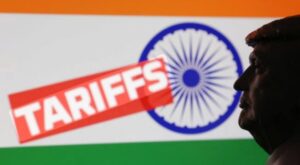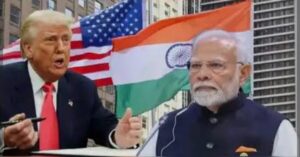Trump Imposes 25% Tariff on India : Know Why and How ?
Trump Imposes 25% Tariff on India : Trade Tensions, Risks, and the Road Ahead with America. How Trump’s aggressive tariff push could hurt India’s exports, trigger a global trade reshuffle, and force India into tough negotiations on Trade deal.
New Tariff War Targets India as Trump Imposes 25% Tariff on India
U.S. President Donald Trump has once again brought trade wars to the center stage — this time by announcing a 25% tariff on Indian goods.
The move, if implemented from August 1, threatens to disrupt a trade corridor worth $130 billion and places India in a uniquely difficult spot among America’s global partners.
Why Trump Imposes 25% Tariff on India and why India Being Targeted?
Trump’s justification for 25% tariffs centers on three main points:
A. Trade Deficit with India
- India exports more to the U.S. than it imports, creating a $46 billion trade surplus in India’s favor.
B. India’s close friendship with Russia
- India continues to buy Russian defense equipment and energy, which Trump sees as conflicting with U.S. strategic interests.
C. BRICS Membership and India’s role
- India’s growing role in the BRICS bloc — seen as a counter to Western economic dominance — is also drawing ire.

These reasons have led Trump to impose steeper tariffs on India compared to others.
While nations like Vietnam (20%), Indonesia (19%), Japan (15%), and UK (10%) face lower rates, India is singled out for a 25% hike, making its exports less competitive in the American market.
Apart from above there are some more reasons for Trump Imposes 25% Tariff on India. like,
- India negotiating so hard with American for Trade deal, which is don’t liked by Trump Administration.
- In Trade deal with India, America wants their dairy products and agricultural products entey into India. But India denied soughting agricultural economy and people depends on those sectors.
- India also wants data centre in own land for indian citizens data privacy, which again don’t like by American Companies.
- American wants india to buy it’s F- 35 fighter jets and many other defence equipments but India denied on that too because those equipments are not suitable for indian needs.
- American wants india to accept it’s genetically modified crops to entre in Indian market which again stopped by India as it’s not allowed as per Indian biodiversity laws.
Impact on Indian Exports due to Trump Imposes 25% Tariff on India
Industries at Risk are :
1. Textiles
- 28% of India’s textile exports go to the US; facing price competition from Bangladesh and Vietnam.
2. Jewellery and Jems
- US market forms 30% of India’s gem exports, now under threat.
3. Electronics and electrical goods
- $12 billion in exports may see supply disruptions and cost hikes.
4. Pharma sector
- Currently spared, but risk remains due to US trade rhetoric.
GDP Impact: Economists warn of a 0.2% dip in FY 2026 GDP if a trade deal isn’t struck by September–October.

India’s Response on 25% Tariffs : Wait, Watch, and Strategize
India is not rushing into retaliation or panic negotiations. Officials are holding out until mid-August, when a U.S. trade delegation is expected to visit New Delhi.
The goal is to pursue a comprehensive trade dialogue, not just a quick fix.
India appears to be betting on long-term gains over short-term pressure. But that’s a risky approach — especially with Trump securing trade deals at a rapid pace.
What’s at Stake for India after Trump Imposes 25% Tariff on India?
If the negotiations fail, India could face the following circumstances :
- 25% base tariffs
- Additional penalties for BRICS affiliations
- “Secondary” sanctions over trade with Russia
The worst-case scenario could severely damage India’s export potential and destabilize sectors that rely heavily on U.S. demand.
Higher costs for American buyers of Indian goods. Reduced demand compared to cheaper alternatives from countries with lower tariff obligations.
What is India’s Offerings on the Trade Deal Table?
India has signaled some flexibility in return for tariff relief:
- Reducing import duties on American automobiles
- Slashing tariffs on U.S. whiskey
- Increasing purchases of U.S. weapons and energy
However, one major sticking point remains: agriculture.
Trump wants India to open its farm market for American agricultural exports, similar to the deal he struck with Japan, which agreed to raise U.S. rice imports by 75%.
But for India, this is a political red line — with nearly 50% of Indians working in agriculture, such a move could trigger massive backlash, especially in an election season.
Global Trade Realignment Underway amid Trump’s Tariff Poem
Trump’s tariff strategy isn’t limited to India. Countries across Southeast Asia, Europe, and even Japan are agreeing to trade deals to avoid harsher tariffs.
Only Canada and China have resisted and imposed retaliatory tariffs.
The rest — including the UK, Japan, Vietnam, and Indonesia — are opting for interim deals to maintain access to the lucrative U.S. market.
India now faces a key question: Can it afford to stand alone?

The Geopolitical Undercurrents with so many Ongoing Wars
Beyond trade, Trump’s recent remarks on India’s diplomatic role — including his claim that India’s ceasefire with Pakistan was due to his intervention — have not gone down well in New Delhi.
The once-favorable sentiment towards Trump in India has cooled.
Yet, this diplomatic distance could give India negotiating room — fewer political expectations, more space to focus strictly on economic terms.
Long-Term Strategy for India : Diversify Away From the U.S. ( amid Trump Imposes 25% Tariff on India )
India is not without a plan. It is working to:
- Finalize Free Trade Agreements (FTAs) with the UK , Australia, UAE, Switzerland, Norway and many others.
- Negotiating Free trade agreements with European Union, Oman, Maldives, Latin American countries.
- Expand partnerships in Africa, Southeast Asia, and Latin America
- Strengthen ties within BRICS, despite U.S. pressure
The vision is clear: reduce dependence on the U.S. market over time.
The Road Ahead for India after Trump Imposes 25% Tariff on India Goods
Trump’s 25% tariff threat is a wake-up call for India’s trade diplomacy. It highlights the fragility of relying too heavily on one trading partner and underlines the urgency of diversification and domestic resilience.
In the short term, India must navigate Trump’s tough stance through strategic concessions, calculated diplomacy, and timing.
But in the long run, building independent trade paths may be the only sustainable way forward.
The world is watching. For India, August could be the turning point in how it engages with a shifting global trade order.
Read Also: De-dollarization coming soon after Trump’s Tariff games
